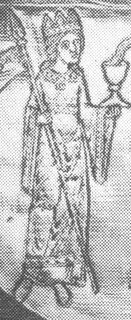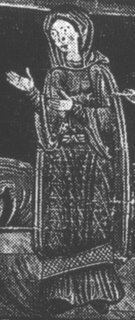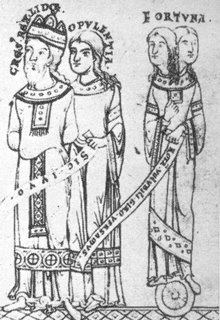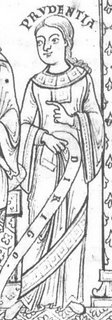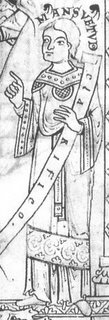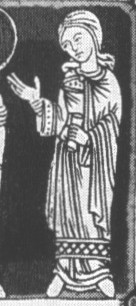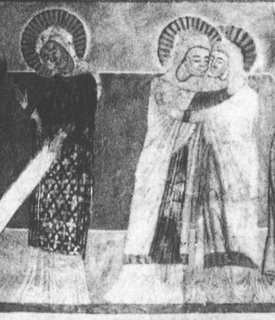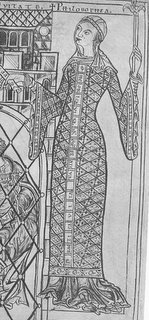
Aldersbach Abbey, Cod. lat. 2599, fol. 106 verso,Germany, about 1200, (Munich, Bayerische Staatsbibliothek).
Mentioned in - "The year 1200: volume II A background survey" article in book: Wormald, F "The monastic library" p169-174
also images available on bildindex (click to load)
- Apparently technique used is a combination of outline drawing with thin coloured washes.
- Aldersback Abbey is in lower (northern) Bavaria (and has a webcam feed :-) )

"Philosophia comforting Boethuis Senator". (see also close-up above)
- the character is philosophy - another virtue personified.
- Yes those are words along the central vertical decorative strip. I doubt this is meant to be literal - I think the artist was just looking for more places to convey messages, like those held in scrolls (see her left hand).
- another cute hat
- look at the fascinating chemise/underdress sleeves - slightly flared at the cuff, and maybe forming a lining in the sleeve. There is certainly something forming that lining in the sleeve that wrinkles so artistically

Prudence as Queen flanked by contemplative and practical philosophy, above the king of Antioch and Nebuchasnezzar
- 3 styles of chemise cuff- flared, decorated with braid and undecorated wrinkled.
- 2 of the women's dresses are short, 1 long
- sleeves fairly uniform in cut - flare from elbow, end halfway down forearm, similar length and shape, and have a ruffly lining

Rhetoric (with sword) and Tullius Cicero f104v
- same features as the others above

Dialect and Aristotle f104
- same cut as previous example, except we can see the neckline on this one, and it has an unusual scalloped edge - never seen that outside this manuscript

Geometry and Cassiodorus f106
- similar cut, except pendulous nature of sleeves exaggerated
- scalloped edged neckline decoration again
- we can see some lacing at her side!

Arithmetic and Boethius f102v
- Unusually short skirt, and worn belted (none of the other female ones are, but some of the men's ones are) which makes it a tiny bit shorter again. In fact the lower half of her tunic looks like a guy's tunic.
- sleeves and other details are pretty much to the same pattern as preceding examples. This is one of the few examples with braid on the tunic sleeve cuffs.
- Note how the man's (Boethius') tunic neckline looks like it is folded in on itself at the centre front.

Music (holding a monochord) and Pythagorias f103
- more of the same design, in the mid calf length tunic variant.
- her neckline looks like it might be folded over like Boethius' neckline in the previous image

Grammatica (holding lamp) and Priscianus f102
- scalloped edge to neck decoration - never seen that outside this manuscript
- strong folds at edge of torso - indicative of lacing
- not sure if full or calf length - can't tell bottom of wrap from tunic

Astronomy and Ptolemy
- scalloped neckline decoration
- Braidcases or some kind of enclosing wrapping over hair
- calf length tunic, without braid on bottom edge
- tunic sleeves drawn differently to other examples. These seem to have a lot more fabric in them. The folds at the edge are formed by the fabric of the sleeve, not by a lining. The fabric sits in folds on top of the arm, probably meaning some of the fabric is cut flaring out above as well as below the arm. I speculate this is one of the "waterfall sleeves" that Rohesia and others have suggested - imagine a sleeve where the end flares out in all directions - rather like putting your hand through the narrow section of a funnel.
Looking at the sleeves again, it is possible that the artist is drawing the front edge straight, and the back edge as ruffled. But that makes no construction sense to me. not only that you would expect both sides to fall the same way, but that the sharp maunche shape that gets narrower before it gets wider doesn't seem conducive to this to me. Oh for a colour copy of these pictures!
And just to prove it's not a fluke, another manuscript with those sleeves:


Legendarium austriacom/Tractatus de Sacramentis Cod. 311 ; fol. 82v-83r. Klosterneuburg, Northern Austria 1150-1200 or 1185-95
Initial T- Saint Mary Magdalene
Initial B - Juliana from Nikomedia
Dodwell says Austria had very strong byzantine influences throughItaly in the first half of the 12th Century.

 And some images from the same manuscript without those sleeves:
And some images from the same manuscript without those sleeves:just to show that they exist in the same manuscript, and the rest of the style is the same.
And annother:

Lot's wife. Salzburg Antiphonary, German, 1080-1150 (library of St Peter's Monastery).
- stylistically, I'd be surprised if it is actually early in the given period.
- Dodwell says Austria had very strong links to Bavaria, and also some byzantine influence
- Davenport says her headwear is a turban. Perhaps it is one like this. If it is a turban, then that is probably a scarf around her neck, with decorated ends.

